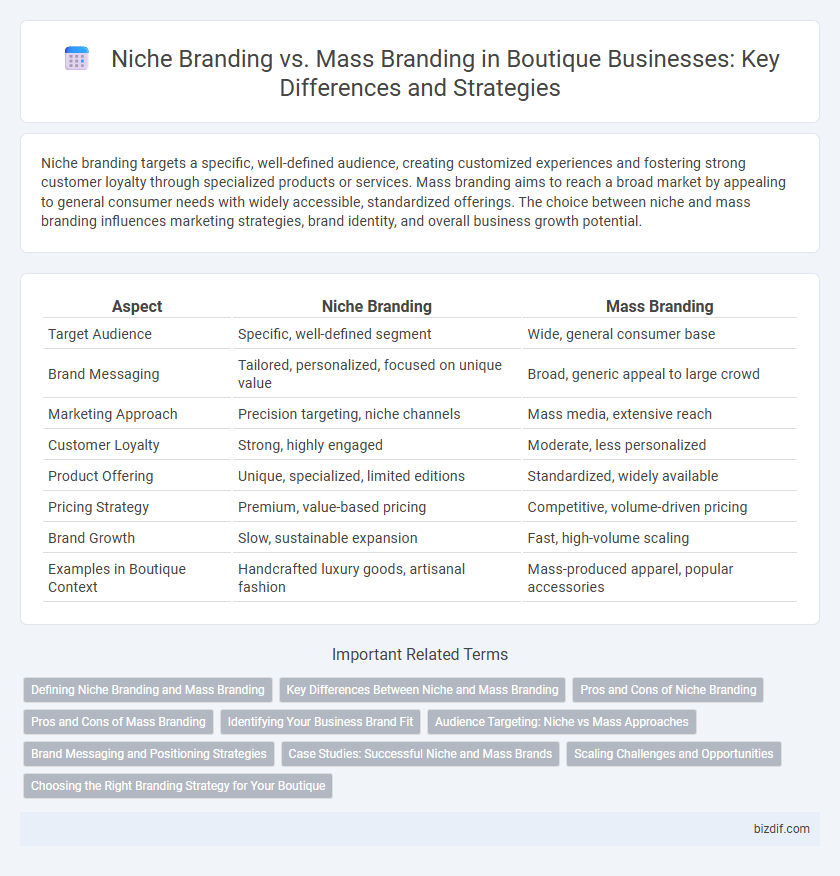Niche branding targets a specific, well-defined audience, creating customized experiences and fostering strong customer loyalty through specialized products or services. Mass branding aims to reach a broad market by appealing to general consumer needs with widely accessible, standardized offerings. The choice between niche and mass branding influences marketing strategies, brand identity, and overall business growth potential.
Table of Comparison
| Aspect | Niche Branding | Mass Branding |
|---|---|---|
| Target Audience | Specific, well-defined segment | Wide, general consumer base |
| Brand Messaging | Tailored, personalized, focused on unique value | Broad, generic appeal to large crowd |
| Marketing Approach | Precision targeting, niche channels | Mass media, extensive reach |
| Customer Loyalty | Strong, highly engaged | Moderate, less personalized |
| Product Offering | Unique, specialized, limited editions | Standardized, widely available |
| Pricing Strategy | Premium, value-based pricing | Competitive, volume-driven pricing |
| Brand Growth | Slow, sustainable expansion | Fast, high-volume scaling |
| Examples in Boutique Context | Handcrafted luxury goods, artisanal fashion | Mass-produced apparel, popular accessories |
Defining Niche Branding and Mass Branding
Niche branding targets a specific, well-defined segment of the market, emphasizing unique product features tailored to meet the specialized needs and preferences of a distinct customer group. Mass branding aims to appeal to a broad audience by offering widely accepted products with universal appeal, leveraging large-scale marketing to build brand recognition and loyalty across diverse demographics. Boutique businesses often excel in niche branding by delivering personalized experiences and exclusive offerings that mass brands cannot replicate.
Key Differences Between Niche and Mass Branding
Niche branding targets a specific, well-defined segment of the market with tailored products and personalized messaging, whereas mass branding aims to appeal broadly to a large, diverse audience. Niche brands emphasize exclusivity, deep customer loyalty, and specialized value propositions, contrasting with mass brands that prioritize wide reach, standardized products, and economies of scale. The strategic focus of niche branding revolves around precision market positioning and unique identity, while mass branding focuses on brand recognition and volume-driven growth.
Pros and Cons of Niche Branding
Niche branding offers the advantage of targeting a specific, well-defined audience, resulting in higher customer loyalty and reduced competition compared to mass branding. However, the limited market size can restrict growth potential and revenue streams. Niche brands often benefit from stronger brand identity and personalized marketing but face challenges in scaling and market diversification.
Pros and Cons of Mass Branding
Mass branding leverages broad market appeal, enabling companies to achieve economies of scale and extensive brand recognition through widespread advertising campaigns. However, this approach often sacrifices personalization and customer intimacy, making it harder to address specific audience needs or create strong emotional connections. The lack of differentiation can lead to increased competition and vulnerability to market shifts, reducing brand loyalty compared to niche branding strategies.
Identifying Your Business Brand Fit
Niche branding sharpens your focus on a specific target audience, creating tailored experiences that foster strong customer loyalty and higher conversion rates. Mass branding aims for broad market appeal, leveraging widespread recognition and large-scale advertising to capture diverse demographics. Identifying your business brand fit involves aligning your product offerings and marketing strategies with either a niche or mass approach, ensuring that your brand message resonates authentically and drives sustainable growth.
Audience Targeting: Niche vs Mass Approaches
Niche branding tailors products and marketing strategies to a specific, well-defined audience, enhancing brand loyalty and customer engagement within a focused segment. Mass branding aims to reach a broad demographic through universal messaging and widespread distribution channels, prioritizing volume over individual connection. Boutique brands leveraging niche targeting benefit from higher customer retention and perceived exclusivity compared to mass brands targeting heterogeneous audiences.
Brand Messaging and Positioning Strategies
Niche branding emphasizes highly targeted brand messaging tailored to specific customer segments, creating strong emotional connections and distinct positioning within specialized markets. Mass branding focuses on broad appeal through universal messaging designed to resonate across diverse audiences, leveraging wide distribution and large-scale advertising. Boutique brands benefit from niche positioning strategies that highlight unique value propositions and authentic storytelling to differentiate themselves from mass-market competitors.
Case Studies: Successful Niche and Mass Brands
Case studies reveal that niche brands like Glossier thrive by targeting specific communities with personalized experiences, driving deep customer loyalty and higher engagement rates. In contrast, mass brands such as Coca-Cola leverage broad market appeal and extensive distribution channels to achieve global recognition and consistent revenue streams. Both strategies succeed by aligning branding efforts with distinct consumer needs, demonstrating the importance of tailored messaging and market segmentation.
Scaling Challenges and Opportunities
Niche branding excels in targeting specific consumer segments with tailored messaging, creating strong brand loyalty but often faces challenges in scaling due to limited market size and resource constraints. Mass branding offers opportunities for rapid expansion and widespread recognition by appealing to broader audiences, yet it risks diluting brand identity and less personalized customer engagement. Boutique brands must balance focused storytelling and authentic engagement with strategic growth initiatives to scale effectively without compromising their unique value proposition.
Choosing the Right Branding Strategy for Your Boutique
Niche branding focuses on targeting a specific, well-defined customer segment, allowing your boutique to build strong brand loyalty and command premium pricing through tailored products and personalized experiences. Mass branding aims to reach a broader audience with standardized offerings, emphasizing wide market appeal and high-volume sales but risking diluted brand identity. Selecting the right branding strategy hinges on understanding your boutique's unique value proposition, customer demographics, and long-term business goals to optimize market positioning and profitability.
Niche Branding vs Mass Branding Infographic

 bizdif.com
bizdif.com